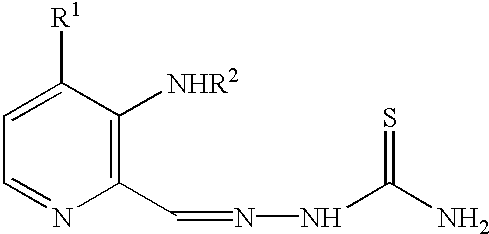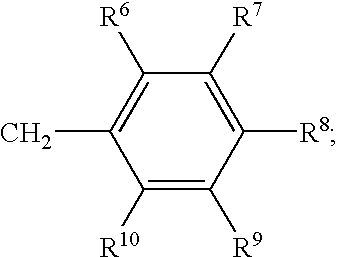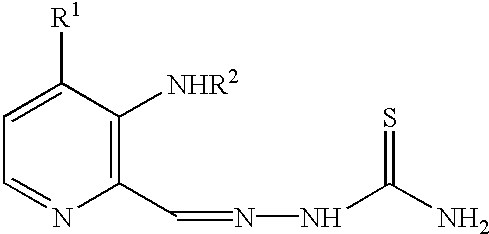Antiviral agents and methods of treating viral infections
a technology applied in the field of antiviral agents and methods of treating viral infections, can solve problems such as inhibition of dna synthesis, and achieve the effects of maximizing the intended effect of compound, favorable pharmacokinetic parameters, and maximum beneficial
- Summary
- Abstract
- Description
- Claims
- Application Information
AI Technical Summary
Benefits of technology
Problems solved by technology
Method used
Image
Examples
example 1
Preparation of 2-chloronicotinic acid methyl ester (18)
[0085] To a mixture of 2-chloronicotinic acid (Aldrich, 100.0 g, 0.63 mol) in 1,4-dioxane (500 mL) was added thionyl chloride (70 mL, 0.96 mol). The suspension was heated under reflux for 22 h with a gas trap to absorb hydrogen chloride gas. After evaporation of the solvent, the residue was dissolved in methanol (300 mL). To the solution was added dropwise triethylamine (TEA, 120 mL, 1.26 mol) at 0.degree. C. over 2 h. The solvents were evaporated and the residue was suspended in ethyl acetate. The precipitate was removed by filtration. The filtrate was concentrated to afford the ester 18 (92.3 g, 86%) as an oil:
[0086] Rf(1:5 v / v ethyl acetate-hexane) 0.38.
[0087] .sup.1H NMR (300 MHz, CDCl.sub.3) .delta.8.53 (dd, 4.8 Hz, 1H), 8.19 (dd, 7.6 Hz, 1H), 7.37 (dd, 7.7 Hz, 1H) and 3.97 (s, 3H).
[0088] .sup.13C NMR (75 MHz, CDCl.sub.3) .delta.164.5, 151.6, 149.6, 140.0, 126.4, 121.9 and 52.5.
example 2
Preparation of 2-styrylnicotinic acid methyl ester (19)
[0089] To a solution of the ester 18 (48.8 g, 0.28 mol) in DMF (450 mL) was added styrene (165 mL, 1.42 mol), palladium acetate (6.5 g, 30 mmol), sodium acetate (47 g, 0.57 mol) and triphenyl phosphine (30 g, 0.11 mol). The mixture was heated under reflux for 22 h. The palladium-catalyst was removed by filtration through a Celite pad. The filtrate was concentrated under reduced pressure, and the residue was dissolved in a minimum amount of ethyl acetate. To the above solution was added hexane. After removal of the precipitate by filtration, the filtrate was concentrated. The resulting crude material was purified by FCC (1:1 v / v ethyl acetate-hexane) to afford the ester 19 (55.0 g, 81%) as a light yellow oil:
[0090] Rf (1 :5 v / v ethyl acetate-hexane) 0.41.
[0091] .sup.1H NMR (300 MHz, CDCl.sub.3) .delta.8.70 (dd, 1H), 8.10 (dd, 1H), 8.16 (d, 1H), 7.94 (d, 1H), 7.64 (d, 2H), 7.4-7.3 (m, 3H), 7.18 (dd, 1H) and 3.94 (s, 3H).
[0092] .su...
example 3
Preparation of 2-styrylnicotinic acid (20)
[0093] A solution of the ester 19 (55.0 g, 0.23 mol) in THF (100 mL) was treated with a 3 N NaOH solution (110 mL, 0.25 mol) for 21 h at ambient temperature. After removal of solvents, the residue was taken up in water and ethyl ether. The phases were separated, and the aqueous phase was washed with ether (2.times.). The resulting aqueous phase was neutralized with a 2 N HCl solution, and the precipitate was then collected by filtration to afford the acid 20 (50.2 g, 97%) as a cream solid:
[0094] .sup.1H NMR (300 MHz, DMSO-d.sub.6) .delta.8.72 (dd, 1H), 8.19 (dd, 1H), 8.10 (d, 1H), 7.86 (d, 1H), 7.62 (d, 2H) and 7.4-7.3 (m, 4H).
[0095] .sup.13C NMR (75 MHz, DMSO-d.sub.6) .delta.167.9, 153.7, 151.8, 138.6, 136.4, 134.5, 128.9, 128.7, 127.2, 125.3 and 122.1.
PUM
 Login to View More
Login to View More Abstract
Description
Claims
Application Information
 Login to View More
Login to View More - R&D
- Intellectual Property
- Life Sciences
- Materials
- Tech Scout
- Unparalleled Data Quality
- Higher Quality Content
- 60% Fewer Hallucinations
Browse by: Latest US Patents, China's latest patents, Technical Efficacy Thesaurus, Application Domain, Technology Topic, Popular Technical Reports.
© 2025 PatSnap. All rights reserved.Legal|Privacy policy|Modern Slavery Act Transparency Statement|Sitemap|About US| Contact US: help@patsnap.com



